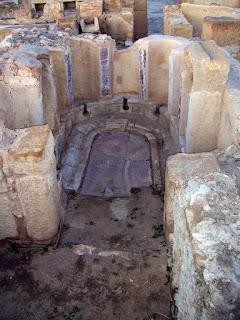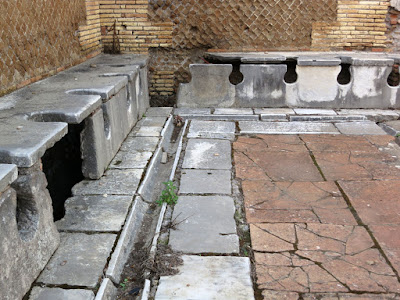The Romans were masters at building and plumbing, as we all know. It seems obvious that expertise would extend to toilets, and so it did. The amount of research on Roman toilets is enormous. We offer only a few examples and thoughts here.
The old Roman seaport city of Ostia, now Ostia Antica, is on a Top Ten list for most Rome visitors. And one can't go there without seeing its common latrine, or sitting on it (hopefully they still let you do that!). RST guest blogger, Martha Bakerjian, featured this photo in her March 6 post this year:
Gemma Jansen, a Dutch historian who may have the distinction of being the world's expert on Roman toilets, published an exceedingly thorough catalog and description of all the toilets at Hadrian's Villa (Villa Adriana, near Tivoli, just outside of Rome). She says the multi-seaters, which the above photo illustrates,
"are easy to detect by the remnants of
seats above a deep gutter, in front of which was a small gutter in which the
toilet sponge could be rinsed. This small gutter is not sunk in the
floor, but normally placed on the floor so that it doubles as a foot-rest.
The gutter was generally built of bricks or roughly cut into travertine blocks;
only a few toilets had sponge gutters of marble. In most cases the toilet seats
were made of wood, but in some cases they are of travertine or marble."
I don't want to think too hard about it, but apparently the "sponge stick" is not a universally accepted historical artifact. The above quotation is from an article by Jansen titled "Social Distinctions and Issues of Privacy in the Toilets of Hadrian's Villa." She also notes the multi-user toilets did not offer much privacy inside, but offered a great deal of privacy from the outside.
The private, single toilet is sometimes hard to distinguish from a nymphaeum, since they both have running water and a drain. There are at least 19 single toilets, and several small nymphaeums in Hadrian's Villa. Jansen says,
 |
This is the Caracalla toilet, pilfered from the Baths of
Caracalla around 1800. The British Museum's description
is as follows: "An ancient Bath-chair of the Pavonazzo
marble, so called by the Italians. In the centre of the seat
is a hollow space in the form of an
extended horseshoe,
thro which the steam was received [sounds like a fancy
Toto brand]. On each side a wheel is worked in relief,
in imitation no doubt, of such wheel-chairs, as were
at that
time executed in wood, resembling in some
degree the chairs of this day, placed on wheels for the
use of lame persons."
|
"The single toilets of the emperor and his high-ranking guests
offered much more privacy. A striking discovery is the single-seat toilets for guests.
From ancient sources it is clear that even high officials might use
multi-seaters, and those found at the baths of Hadrian's Villa confirm this,
but the provision of single-seaters specially for guests shows that, when space
and money were no object, they preferred single toilets."
The toilets' size and shape, the fact that there apparently are no urinals, and the reading of some statues have raised the question of how Roman males held their penises when they peed. Jansen is trying to determine if they simply sat when they peed, and then that they held their penises to hide them. Showing a statue (from the British Museum) of a boy peeing, she states, "the
penis shows a completely different way of thinking, because the Romans and
Greeks wanted their penises to be small. Because that was beautiful."
At a recent small group tour of The Los Angeles County Museum of Art's exhibition, "To Rome and Back: Individualism and Authority in Art, 1500-1800" (on until March 17), we had a lengthy discussion on penis size while viewing The Bateman Mercury (below).
Our guide, an expert in Greek and Roman statues, talked about the research of one of her fellow graduate students into penis size in ancient Greece and Rome. That researcher came to the same conclusion as Jansen, that a smaller penis was more desirable. The larger penis, she said, was associated with satyrs, who could not control their libidos, and control was a virtue in the ancient world.
For more on Roman styles of peeing and Roman toilets, including those found throughout the world:
Caroline Lawrence is an indefatigable, if hippy-dippy, source. I quoted above from a sit-down interview she had with Jansen, which is reported in excruciating detail on The History Girls blogspot. Here she speculates on 10 things Romans used for toilet paper (including the pine cone - ouch! worse than my Italian grandmother's Sears catalog pages). And here she writes about the sewers of Herculaneum. She also writes kids' Roman mystery books.
 |
The latrines in the Baths of the Laberii at
Uthina (Tunisia) (from Carole's "Following
Hadrian" blog).
|
On her English language blog, Following Hadrian, French blogger, Carole, has an amazing collection of her own photos of Roman toilets throughout the Western - and North African - world. These include several more photos of the Ostia Antica latrines, as well as the Tunisian one at left.
There's a nice post by Stephanie Pappas on Pompeians having upstairs toilets on the Live Science blog. (Photo from her blog below.)
Barry Hobson's 2009 book is Latrinae Et Foricae: Toilets in the Roman World.
Jansen has published widely on Roman toilets. She edited a 2011 book, "Roman Toilets, Their Archaeology and Cultural History." (Okay, at $58, no, I didn't get it.)
Dianne




No comments:
Post a Comment